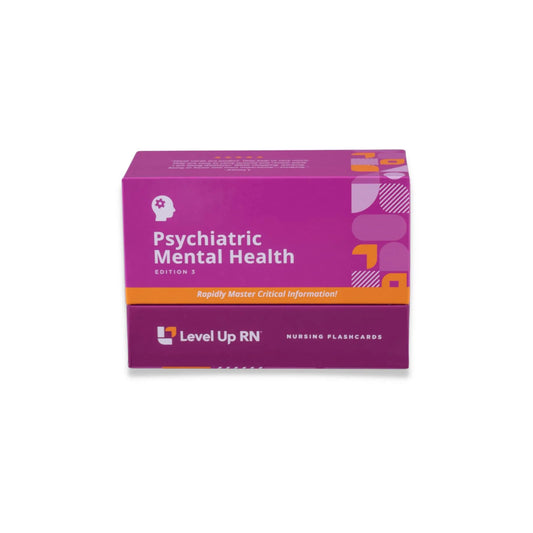Psychiatric Mental Health, part 27: Disorders - Major Depressive Disorder
Major depressive disorder (MDD). The risk factors, symptoms, diagnosis, treatment, and nursing care for a patient with depression. Other depressive disorders, including: persistent depressive disorder, premenstrual dysphoric disorder, and seasonal affective disorder.
Full Transcript: Psychiatric Mental Health, part 27: Disorders - Major Depressive Disorder
Full Transcript: Psychiatric Mental Health, part 27: Disorders - Major Depressive Disorder
Hi, I'm Cathy with Level Up RN. In this video, we are going to be talking about major depressive disorder, or MDD, as well as a few other types of depression. And at the end of the video, I'm going to give you guys a little quiz to test your knowledge of some of the key points I'll be covering, so definitely stay tuned for that. And if you have our Level Up RN psychiatric mental health nursing flashcards, definitely pull those out so you can follow along with me.
Major depressive disorder is a condition that is characterized by persistent low mood, lack of energy, and the absence of pleasure. Risk factors associated with major depressive disorder include a personal or family history of depression, having a chronic illness, as well as being female. In addition, studies show that unmarried individuals are at higher risk for MDD as opposed to people who are married. In addition to a persistently sad mood, lack of energy, and anhedonia, which means lack of pleasure, signs and symptoms of major depressive disorder include poor concentration, changes in appetite and weight, feelings of worthlessness, suicidal thoughts, sleep disturbances, moving or talking more slowly, and having difficulty with decision-making.
Diagnosis of major depressive disorder is indicated when the patient has persistent symptoms that last at least two weeks, and those symptoms interfere with their social and or occupational functioning. It's also important to rule out other causes of the symptoms, such as an underlying medical condition, like hypothyroidism, or certain medications. Other depressive disorders besides MDD include persistent depressive disorder, which is characterized by a chronically depressed mood that lasts at least two years, but has symptoms that are less severe than MDD. We also have premenstrual dysphoric disorder, which is characterized by severe depression and irritability in the week or two prior to menstruation. And then with seasonal affective disorder, we have depression that occurs in the winter months and is associated with decreased sunlight.
Treatment of depression includes talk therapy, as well as medications such as SSRIs, SSNRIs, tricyclic antidepressants, MAOIs, and atypical antidepressants. For treatment-resistant depression, there's a number of therapies that are available. This includes transcranial magnetic stimulation, vagus nerve stimulation, and electroconvulsive therapy. And if you want more information about those therapies, there is a video earlier in this playlist that goes into detail about those therapies. We also have assertive community treatment or ACT, which is really focused on helping individuals with severe and persistent major depressive disorder with psychosis. So this is a multidisciplinary team approach that really focuses on treating the patient in the community and helps to prevent hospitalizations as well as incarceration. And then for seasonal affective disorder, light therapy is another treatment option.
In terms of nursing care, safety is priority. So for any patient who has depression, we want to assess that patient for risk of self-harm or suicide. For any patient who is at risk for suicide, we need to implement one-on-one observation. We would never assign a patient with major depression to a private room. So that is something you may very well be asked about on a nursing exam. We want to assign that patient to a room that is near the nursing station, and we want to make frequent rounds at irregular intervals. We also want to closely monitor our patients during medication administration so they don't discard the medication or save it with the intention of overdosing at a later time. And of course, we want to use therapeutic communication and encourage the patient to share their feelings.
All right, it's quiz time and I've got three questions for you. Question number one, what do you call depression that occurs during the winter months and is associated with decreased sunlight? The answer is seasonal affective disorder. Question number two, what is the priority assessment for a patient with major depressive disorder? The answer is you need to assess them for risk of self-harm and/or suicide. Question number three, a patient with major depressive disorder should be placed in a private room. True or false? The answer is false. We would not place a patient with major depression in a private room. Okay, that is it for this video. I hope you have found it helpful. If so, leave me a comment. I would love to hear from you. Take care and good luck with studying.


